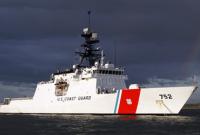
Photo: Reuters / Molly Riley
The USCGC Stratton is the Coast Guard’s newest cutter. Built at Ingalls Shipbuilding of Pascagoula, Miss., she was acquired by the Coast Guard on September 2, 2011 and officially commissioned on March 31, 2012. Roughly a month after the 418′ foot long cutter went into service, however, the ship’s engineers discovered what is described as a “golf-ball sized” hole and four pin-hole leaks in its hull plating. The ship is scheduled to enter a drydock for repairs and to determine the cause of the hull pitting. The Coast Guard says that no similar problems have been found in the two other ships of the class.
Coast Guard’s newest ship filled with holes
The Stratton is part of the US Coast Guard’s 25-year, $24 billion, Integrated Deepwater System Program (IDS Program or Deepwater) to replace all or much of the United States Coast Guard’s fleet, including aircraft, ships, and logistics and command and control systems. Over the last decade, it has had a very difficult start.
The Stratton is the third National Security Cutter (NSC), also referred to as Legends Class Cutter. As reported by GlobalSecurity.org : By early 2007 it appeared that the NSC, as designed and constructed, will not meet performance specifications described in the original Deepwater contract. Specifically, due to design deficiencies, the NSC’s structure provides insufficient fatigue strength to be deployed underway for 230 days per year over its 30-year operational service life under Caribbean (General Atlantic) and Gulf of Alaska (North Pacific) sea conditions. Ironically, the design of the Stratton was modified, with additional structure added to meet these concerns, at an added cost of approximately $15 million.
Other “Deepwater” program have also had serious problems. As part of IDS, the Coast Guard decided to modify and lengthen 49 off the highly successful 110′ Island Class Cutter. Eight cutters were lengthened by 13′ feet at a cost of roughly $100 million in 2005 and 2006. Shortly after these cutters were returned to service, their hulls and decks began to buckle during operation. All eight cutters have since been pulled from service and are expected to be scrapped. In August of last year, the Coast Guard filed a law suit against the shipyard who performed the modifications. Nevertheless, the Coast Guard has come under severe criticism for its mis-management of the program.
